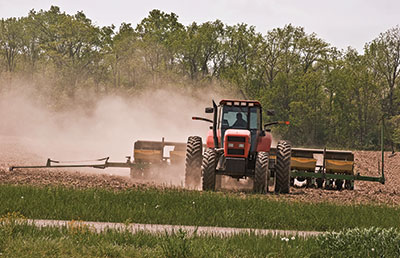Equipment Sale Trap

The mass sale of the farmer’s equipment line has become a hot topic again as of late. As farmers approach retirement their two biggest concerns are generally equipment sales and carryover grain. Related to the equipment, many farmers structure their buyout to a child or neighbor on a payment plan (for example, on a line worth $1 million the buyer will pay $100k per year for ten years). The farmer generally believes that by spreading out the payments, it spreads out the tax burden. This is not true.
The IRS considers sales structured in this nature as installment sales. In an installment sale, the seller may recognize taxable income as payments are received and in amount equal to the overall percentage gain calculated on the sale, IF the sale meets the proper criteria. Selling farmland on contract works well in this scenario, but equipment sales are generally not treated in the same fashion given that the equipment is usually fully depreciated at the time of the sale. The instructions to Form 6252 are very clear and state: “Any ordinary income recapture under section 1245 or 1250 (including sections 179 and 291) is fully taxable in the year of sale even if no payments were received.” So in our example, if the farmer sold his equipment under the payment structure proposed, the entire $1 million is taxable at the date of the sale, not when the payments are received. Lease to own structures work the same way.
So what do you do? A few options include:
• Sell piece by piece. This works better if selling to family, but essentially the combine goes in year one and is paid in full, next year the planter and so on down the line. It spreads the payments and the tax liability out by completing only one sale at time. However, it also leaves the farmer at risk for market value depreciation. If the buyer is using the other pieces of equipment not included in the current year sale, they should pay fair market value rent.
• Contribute to a charitable remainder trust (CRT) and then sell. The CRT will allow for a stream of payments and spread-out income over time. It is a bit more complicated of a technique but works well for those that are charitably minded anyway, as a portion of the sale proceeds must end up with a charitable organization. Generally, the charity receives 10%, but considering how the annuity stream is structured and grows, the seller can often get more than the initial sale proceeds anyway.
• Lease it. Leasing without a predetermined buyout or requirement at the end of the term can provide the farmer with an income stream and allow the buyer to accumulate some additional capital to acquire bigger chunks of ownership of specific pieces. However, the farmer bears the risk of the decline in value until sold.
• Sell it all and pay the tax. The current market presents a great opportunity to sell equipment. The sales are not subject to self-employment tax which is another benefit. Maybe just paying the tax is worth considering if the price is 125% of what it was two years ago.
Be careful when structuring equipment sale agreements. At the end of the day, it is not just the tax consequences that matter. Make sure to consider cash flow, market value and what makes the most sense for your overall situation.
Kelly Jackson Hardy is a certified public accountant and business advisor specializing in income taxation, accounting services, and succession planning for farmers, privately-held elevators and supply dealers, and cooperatives. Kelly is a principal with CliftonLarsonAllen in Princeton, Illinois, as well as a regular speaker at tax and estate planning seminars. Kelly was raised on a hog, row crop and cattle farm in central Illinois and has been involved in the ag industry her entire life. Kelly, her husband, and two sons are active in 4-H and operate a small feeder calf operation and pumpkin business.

Comments are closed.